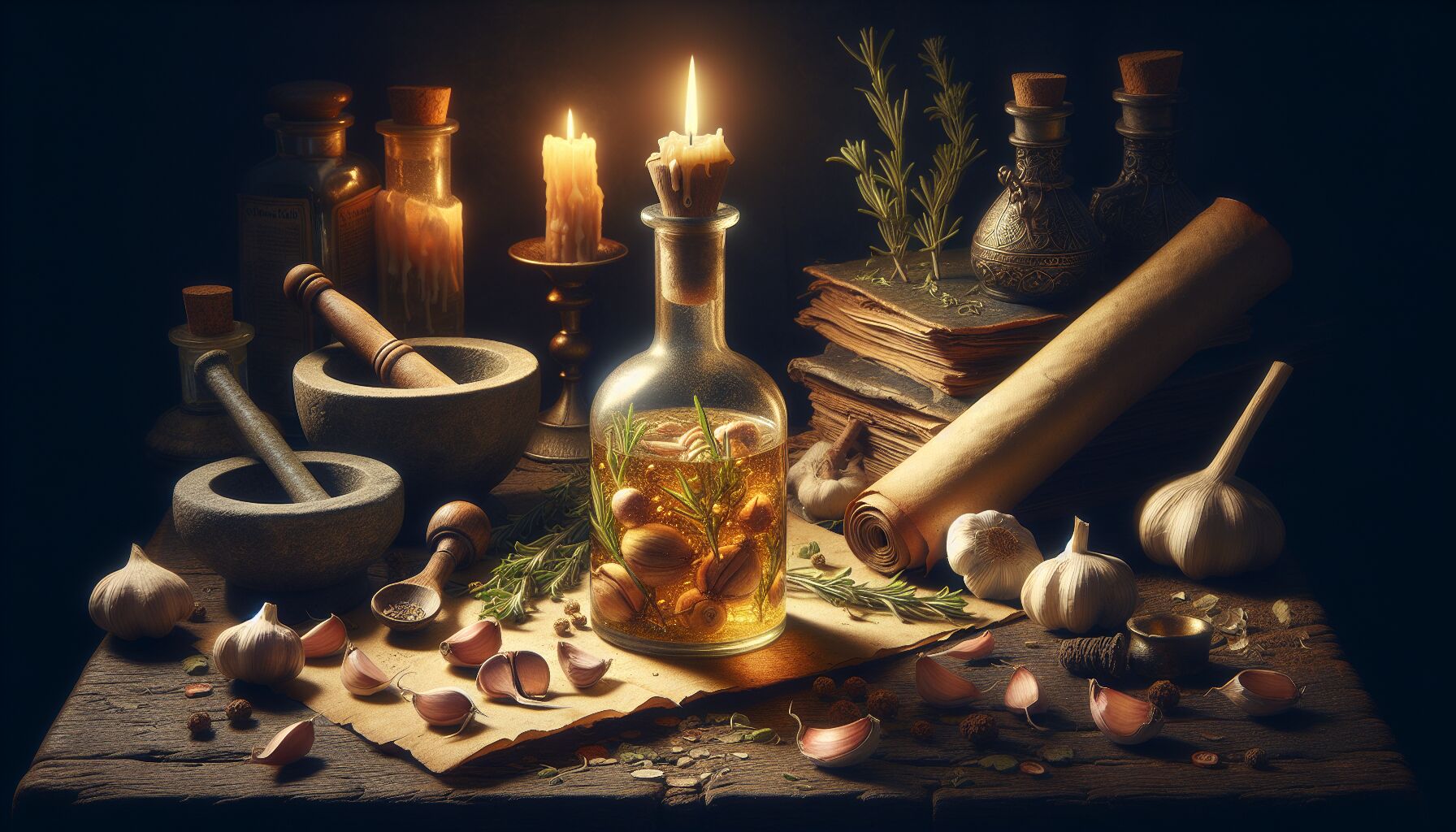 Garlic, rosemary, and thyme—today, they might sit neatly in kitchen spice racks, waiting to season a roast. But centuries ago, these humble herbs were frontline warriors in the battle against the plague. Medieval medicine wasn’t just about desperate prayers and bloodletting; people relied heavily on herbal tonics to fight disease, believing plants held both divine blessings and potent medicinal properties.
Garlic, rosemary, and thyme—today, they might sit neatly in kitchen spice racks, waiting to season a roast. But centuries ago, these humble herbs were frontline warriors in the battle against the plague. Medieval medicine wasn’t just about desperate prayers and bloodletting; people relied heavily on herbal tonics to fight disease, believing plants held both divine blessings and potent medicinal properties.
One of the most famous plague remedies of the Middle Ages was the infamous “Four Thieves Vinegar.” Legend has it that during the Black Death, a group of thieves ransacked sick households but miraculously never fell ill. When caught, they revealed their secret—a potent mix of vinegar infused with garlic, rosemary, sage, and cloves. Whether or not the story is entirely true, the antiseptic and antimicrobial properties of these ingredients are well-documented. Garlic, for instance, contains allicin, a sulfur compound known for its antibacterial effects, while rosemary has long been linked to improved circulation and immune support.
Another disease-fighting superstar was angelica root, sometimes called the “Holy Ghost Plant.” Monks grew it in monastery gardens, believing it could ward off evil spirits—including those that brought disease. Later research suggests angelica did have mild antibacterial properties, though, let’s be honest, it probably wasn’t enough to single-handedly stop the plague. Still, imagine the desperation—people would chew on its bitter stems, hoping for some divine relief.
Mugwort and wormwood, both relatives of modern-day absinthe’s key ingredient, also found their way into medieval herbal tonics. These bitter herbs were thought to cleanse the blood and expel toxins, which makes sense given their mild antimicrobial effects. And then there was rue—a sharp-smelling plant associated with protection against contagion. In fact, plague doctors often stuffed their beaked masks with rue and other fragrant herbs to purify the air they breathed. Was it effective? Maybe not in stopping the plague, but it probably made their working conditions a little more bearable.
Saffron, now worth a small fortune, was another favorite in medieval plague remedies. Medicinal texts of the time describe it as a “warming” herb that could help strengthen the heart and fortify the body against infections. Modern science suggests saffron does have antioxidant properties, though medieval apothecaries certainly weren’t running clinical trials.
Then there were simpler ingredients—honey and vinegar were often used as carriers for these powerful herbs, helping to extract their medicinal qualities. The acidity of vinegar acted as a preservative, ensuring these herbal tonics lasted long enough to be useful. Honey, beyond its sweet taste, was valued for its soothing properties and natural antibacterial strength—something people still rely on today for sore throats and wounds.
Of course, just because these remedies existed doesn’t mean everyone survived. The Black Death still ravaged Europe, killing millions. But people fought back with whatever knowledge they had, grasping at every ounce of wisdom passed down through generations. As the medieval proverb goes, “He who has health, has hope; and he who has hope, has everything.”
And really, isn’t that still true? Even now, traces of medieval herbal wisdom linger in modern medicine, proving that some things—garlic, honey, and a little bit of hope—never go out of style.
How medieval herbal tonics were prepared
Creating these herbal tonics in medieval times wasn’t just a matter of tossing a handful of herbs into a pot and hoping for the best. The process was methodical, shaped by both folk tradition and the limited scientific understanding of the time. Many plague remedies followed a similar pattern: herbs were infused in vinegar, steeped in wine, or preserved in honey to extract their medicinal properties. The resulting mixtures often tasted strong, sometimes unbearably bitter, but considering the alternative—falling victim to the plague—a little unpleasantness was a small price to pay.
Monasteries played a vital role in refining these preparations. Monks, acting as early pharmacists, carefully documented recipes in herbals—manuscripts detailing the uses of medicinal plants. Some of these texts survived, giving us detailed instructions on how medieval medicine was practiced. For instance, a 14th-century English herbal describes boiling sage, thyme, and wormwood in vinegar, then straining the liquid and storing it in clay jars. The vinegar served as both a preservative and a medium for drawing out the healing compounds of these plants. The final product could be consumed, applied to wounds, or even used to wipe down surfaces in hopes of keeping contagion at bay. In a time where germ theory was centuries away, this was as close as people got to disinfection.
Some tonics required fermentation, an ancient method that added an extra layer of complexity. Mead, a honey-based alcoholic drink, was sometimes infused with antibacterial herbs like ginger and cinnamon. The slight alcohol content likely acted as an additional preservative, making the tonic more effective over time. Other concoctions involved infusing herbs into oil or tallow, creating balms meant for external application. Physicians—often a mix of trained doctors, barbers, and apothecaries—would recommend these mixtures both as medicines and as protective charms. Whether the tonics truly fought infection or merely provided a psychological boost, they became an indispensable part of surviving an era rife with disease.
The preparation of these remedies wasn’t just a necessity; it was often a communal event. Households would gather to crush herbs with mortar and pestle, boiling them over open hearths while sharing knowledge passed down for generations. Some families had their own signature mixtures, much like secret recipes handed down today. Given how devastating the plague could be, knowing how to prepare a good tonic might literally mean the difference between life and death.
One fascinating approach involved smoking or burning certain herbs. Juniper, rosemary, and frankincense were sometimes set ablaze inside sickrooms, the belief being that the aromatic smoke would purify the air. There’s actually some merit to this practice—many of these plants contain antimicrobial compounds that, when burned, may have reduced airborne pathogens. Voltaire once remarked,
“The art of medicine consists of amusing the patient while nature cures the disease.”
Whether these methods truly cured anyone is debatable, but they certainly gave people something tangible to rely on in a time of chaos.
Regardless of how effective these tonics were, their careful preparation reflects a deeply human instinct: the drive to fight back, to survive through knowledge and resourcefulness. The same desire for well-being that pushed medieval healers to perfect their plague remedies still exists in modern alternative medicine. And, surprisingly, some of their methods weren’t too far off from what we still use today.
Modern applications of medieval herbal remedies

The same plants that medieval healers painstakingly stewed and distilled for their herbal tonics still show up today—but often in forms far more refined and accessible. Modern science has peeled back the layers of tradition to analyze what actually worked in these ancient plague remedies, and while not every medieval cure stands up to scrutiny, many of them hold surprising merit. Garlic, for instance, once considered a mystical protector against illness, is now well-documented for its antimicrobial properties. In fact, allicin, the sulfur-rich compound in garlic, has shown effectiveness against certain bacteria and viruses, reinforcing why it featured so heavily in medieval medicine.
Take vinegar-based herbal infusions, like the legendary “Four Thieves Vinegar.” While there’s little evidence that it allowed looters to rob plague houses unscathed, the antimicrobial properties of vinegar, combined with the antiseptic qualities of herbs like rosemary and thyme, make a compelling case for its value. Apple cider vinegar, now a staple in health-conscious circles, echoes this medieval practice. Many people still drink it or apply it to wounds, much like medieval apothecaries might have recommended centuries ago.
Herbs like sage and thyme, once boiled into pungent concoctions to purify the air, are now recognized for their antibacterial and anti-inflammatory benefits. Thyme essential oil, for example, contains thymol, which is used in modern antiseptics and even some mouthwashes. And let’s not forget honey. Medieval healers didn’t fully understand why it worked, but they knew it did—applying it to wounds and mixing it into medicinal pastes. Today, we know it has powerful antibacterial properties, and medical-grade honey is still used for treating burns and infections.
Beyond individual ingredients, the philosophy behind medieval herbal tonics continues in holistic and alternative medicine. Many contemporary herbalists employ methods strikingly similar to those used in medieval times: tinctures (herbs steeped in alcohol, much like old plague remedies), decoctions (boiling plant material to extract medicinal compounds), and infused oils (used in balms and salves). While modern medicine has surpassed medieval approaches in treating infections, there’s a growing appreciation for how these ancient practices can support overall well-being.
Even in mainstream medicine, remnants of medieval herbal wisdom persist. Some of the most effective modern drugs owe their origins to plants once featured in plague-era remedies. Take aspirin—its precursor, salicin, comes from willow bark, which was used for pain relief as far back as ancient civilizations. And then there’s artemisinin, derived from wormwood, a close relative of the mugwort used in medieval practices. Today, it’s one of the most powerful antimalarial drugs available.
There’s also a growing interest in reviving traditional preparations, particularly in light of antibiotic resistance. Researchers are returning to natural antimicrobials, testing combinations of herbs similar to those medieval physicians swore by. Some recent studies suggest that herbal blends, like those once used in plague outbreaks, may have synergistic effects—meaning the combination of ingredients is more powerful than any single herb alone. This idea isn’t new; medieval monks and healers instinctively understood that certain plants worked better together, even if they couldn’t explain why.
Yet, there’s something more than just science at play here. Part of the appeal of medieval plague remedies lies in the connection they offer to the past. When people brew elderberry syrup to fend off colds or make fire cider with horseradish and garlic, they’re channeling practices that stretch back centuries. Maybe the effectiveness of these remedies isn’t just chemical. Maybe it’s also about the reassurance that comes with tradition—knowing that during the darkest times in history, people turned to the same plants and potions we still rely on today.
 DS Haven In Light Of Things
DS Haven In Light Of Things

